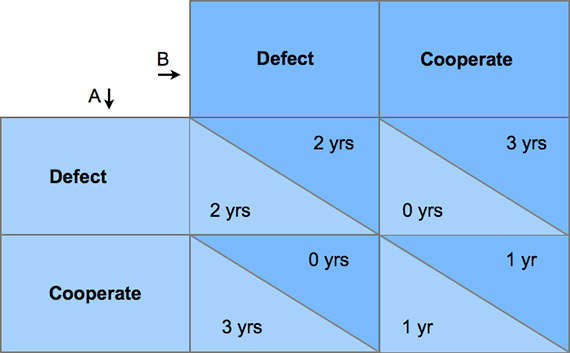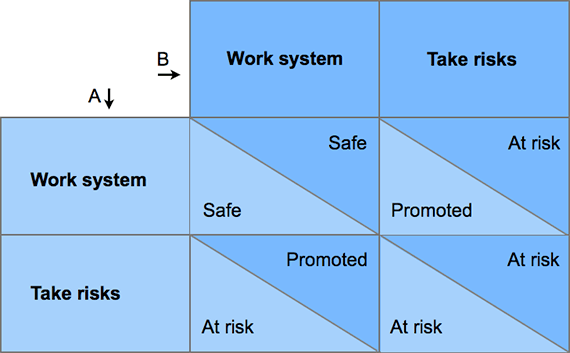Have you ever seen an organization with a mission statement like this?
We aim to produce a product or service that's more or less adequate. Any improvement will be painful. The work culture will range from OK to back-stabbingly political. Hopefully things won't suck so much that our best people quit.
Probably not.
But have you ever seen an organization that this statement describes?
Probably yes.
No leaders want their organizations to be mediocre. Most espouse values that are all about excellence and virtue: "the best provider of this or that, with happy employees who treat each other with care and respect," etc.
And yet, somewhere between values and action, things often go badly astray.
Why?
One answer is bad game design: Too many leaders get the goals right, and the game all wrong.
The term "game" is often used pejoratively: "Don't play games with me, just give it to me straight!" But at a basic level, most human interactions are games -- you make a move, I make a move in response.
That means that a better understanding of game theory can make those interactions healthier, happier and more productive.
Many people know all they know about game theory from the book or movie A Beautiful Mind, about the brilliant mathematician and game theorist John Nash.
The topic can be abstruse, but the basics can be grasped by any manager or executive. A lot can be learned by mastering one prototypical game, known as the Prisoner's Dilemma:
Two people have been arrested for committing a crime, and are being held in separate cells. The authorities offer each a deal. If both confess, thereby betraying each other, each will get two years in jail. If neither confesses, each will get one year. If one confesses and the other doesn't, the confessor will get no jail time and the hold-out will get three years.
What should they do? It helps to diagram the situation as follows, where A and B represent the prisoners:
It turns out that the most logical answer for each prisoner is to confess.
Let's say you're A. If it turns out that B didn't confess, you'll be happier if you did: you'll go free. And if B did confess, you'll still be better off: you'll get two years instead of three.
In game theory, the two choices are generalized as "defect" (confess) and "cooperate" (keep quiet). In a Prisoner's Dilemma, "defect" is always the right solution.
The fiendish thing about it is, it's not the best solution. That would be for both to cooperate, which would give each a one-year sentence.
But neither can trust what the other will do, so logic dictates making the second-best choice.
Sound familiar?
The Prisoner's Dilemma describes many situations we all face in real life -- especially at work.
Some organizations even build it into their cultures, to self-destructive effect.
Many have implemented an employee review system known as "stack ranking," made famous by Jack Welch when he was the CEO of GE. It's also known as the "vitality curve" and "rank and yank," among other names.
In stack ranking, a tranche of the lowest-ranked employees is let go each year. The idea is that this will cause the average standard of performance to rise, inevitably (if brutally).
I would argue that the reverse is likely. That's because stack ranking sets up a collection of what we might call Employee's Dilemmas. These dilemmas are based on choices like whether or not to collaborate with colleagues, accept responsibility for mistakes or take creative risks.
Unless all employees have an extraordinary level of trust both in the review process, and in each other, stack ranking makes "default" the logical choice every time: only pretend to collaborate, be sure to dodge responsibility and always play it safe.
In other words, it's a recipe for mediocrity. According to some critics, it explains many of the difficulties Microsoft has had in succeeding outside its former dominance of office software.
Whether or not that's true, Microsoft would be far from alone. Stack ranking, and other poorly designed games, generate unintended consequences all over the for-profit, nonprofit and government sectors.
The influence of the underlying game is often missed though, because of the instinct to blame dysfunction on the people involved -- "If only I didn't work with such jerks!"
But blaming people is seldom the answer. After all, they're just playing by the rules they've been taught.
It's the rules that need to change. And they can be changed, designed to reward cooperation and punish defection, instead of the reverse.
Below are some rules that do just that. They too are based on game theory, drawing in part on experimental findings described in the book "The Art of Strategy," by professors Avinash Dixit of Princeton and Barry Nalebuff of Yale (for example, in Chapter 3).
- Make careful choices for your "defect" and "cooperate" options. If you want creativity, for example, you must reward, not punish, creative risks -- even if they sometimes lead to failure, as they certainly will.
- Describe your organizations standards of behavior very clearly, not in abstractions like "excellence," but in concrete terms that people can picture and model. Story-telling is a powerful tool for this.
- Make sure defection is reliably caught, and cooperation reliably celebrated. When defection succeeds, it soars. But it turns out that many people have a bias towards cooperation. They just need to believe that, at least where they work, the right thing is also the smart thing.
These are rules for a better game, and they're likely to produce better behavior. I believe many organizations would be far better off if they simply (that's not to say easily) took a hard look at the game they're playing now, and changed the rules to ones like these.
But I also believe we can do even better than that.
How? I'll describe it in a future post.
You can find all my posts as they become available at huffingtonpost.com/spencer-critchley. To be notified, click one of the "Get Updates" links up top.


